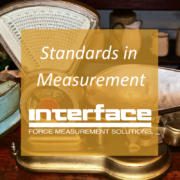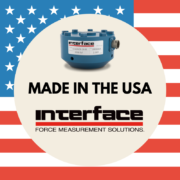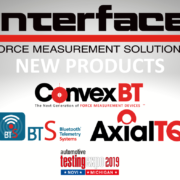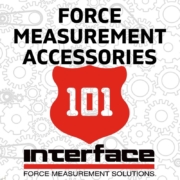Essential Interface Accessories for Force and Torque Measurement
 Investing in accurate and reliable force measurement equipment is crucial for any application demanding precision. However, the true power of your load cells, torque transducers, and instrumentation lies in pairing them with the right accessories.
Investing in accurate and reliable force measurement equipment is crucial for any application demanding precision. However, the true power of your load cells, torque transducers, and instrumentation lies in pairing them with the right accessories.
Interface offers a comprehensive range of accessories designed to enhance performance, expand versatility, and ensure maximum value from your test and measurement investments.
Why Accessorize?
Interface accessories are more than just add-ons; they are essential components that contribute to the following:
Enhanced Accuracy: Precisely machined base kits, mounting hardware, jam nuts, mating connectors, and bearings minimize alignment errors and ensure optimal load application, leading to more accurate measurements.
Improved Reliability: High-quality cables and connectors guarantee signal integrity, while durable enclosures protect your instruments from harsh environments, ensuring consistent and dependable performance.
Increased Versatility: Thread adapters and load buttons allow you to customize your force measurement setup for various applications and testing configurations.
Streamlined Workflow: TEDS (Transducer Electronic Data Sheet) technology automates sensor identification and data management, simplifying your testing process.
Navigating the World of Interface Accessories
Choosing the right components can seem daunting with a vast selection of accessories. Interface’s new Accessories Selection Guide simplifies this process, providing a roadmap to the ideal accessories for your specific needs. This guide categorizes accessories based on product type:
- Calibration System Accessories: Find accessories like load cell simulators and RCAL resistors for efficient and accurate calibration. Accessories Guide for Calibration Systems
- Instrumentation Accessories: Explore enclosures, mounting options, and cables designed to protect and optimize your Interface instruments. Accessories Guide for Instrumentation
- Load Cell Accessories: Discover a range of mounting plates, clevises, load buttons, and adapters to ensure accurate load application and measurement. Accessories Guide for Load Cells
- Torque Transducer Accessories: Find couplings, adapters, and mounting solutions specifically designed for torque measurement applications. Accessories Guide for Torque Transducers
These components are used in demanding engineering applications. Each accessory contributes to your measurement system’s overall performance and longevity, from cables designed to preserve signal integrity in high-noise environments to robust mounting hardware that minimizes alignment errors under heavy loads.
Essential Interface Accessories
- Cables transmit signals between the transducer and your data acquisition system. Choose cable assemblies with appropriate shielding and connectors to minimize noise and ensure signal integrity, especially in environments with electrical interference. Based on your setup, consider cable length and flexibility. Interface provides standard and custom length and shielded cables with various connector types.
- Calibration adapters provide a precise and repeatable method for applying known loads during calibration, ensuring long-term accuracy. Select calibration adapters compatible with your transducer’s capacity and geometry. Consider material and construction for durability and stability. Interface’s off-the-shelf and custom calibration adapters are made from high-grade alloy and stainless steel.
- Mounting hardware securely attaches the load cell to your test setup, ensuring proper load distribution and minimizing errors caused by misalignment or movement. Choose mounting plates or clevises that match the load cell’s mounting holes and provide adequate strength and rigidity for the application. Consider environmental factors like corrosion resistance. Interface mounting plates, clevises, and jam nuts are made from high-grade materials and machined to tight tolerances.
- Load buttons, not to be confused with load button load cells, convert universal load cells to compression-only applications. They protect the load cell from off-axis loading and ensure accurate force application compatibility with your load cell model. It is crucial to consider the load buttons’ capacity and dimensions. Interface offers load buttons for Interface LowProfile Load Cells, S-Type Miniature Load Cells, and our Mini Beam (MB) line of load cells.
- Rod end bearings reduce alignment errors in tension applications by allowing for slight angular movement. Choose bearings with appropriate load capacity and consider factors like misalignment angle and environmental conditions. Interface offers high-grade rod end bearings for various load capacities.
- TEDS embeds electronic identification and calibration data within the transducer for easy setup and data management. By automating sensor identification and calibration data transfer, TEDS can save time and reduce errors. Consider the Transducer Electronic Data Sheet (TEDS) if you require automated data acquisition or need to track sensor information across multiple tests. TEDS is available on new or existing Interface transducers and complies with the IEEE 1451.4 standard.
When choosing your components, consider the following factors: application requirements, environmental conditions, connectivity, mounting and alignment, and data acquisition options for your transducers. By thoughtfully selecting and integrating Interface accessories, you transform your force measurement equipment into a genuinely high-performance system capable of delivering accurate, reliable, and insightful data for any application.
If you’re unsure which accessories are best for your application, don’t hesitate to contact Interface’s experienced application engineers. They can provide personalized guidance and recommend the optimal accessories to ensure accurate, reliable, and efficient force measurement.







